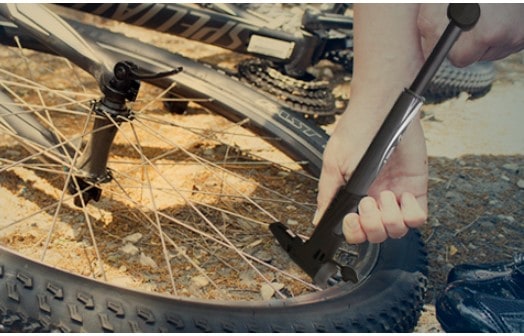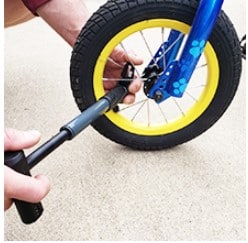A bike pump comes in handy when fixing a tire puncture and replacing the tire. So, it frustrates a lot when it fails. Are you wondering, ‘why is my bike pump not working?’
Most bike pumps fail to work due to air leakage. That happens mostly when the pump head is improperly placed, the seal is broken, or the hose has a crack or is just loose. Other causes include a dry gasket, a wrongly placed nozzle, or a worn-out pump.
So, before you can take any step, first diagnose the problem. You have to know why your bike pump isn’t working to fix it accordingly, and that’s where I come in.
I’ll explain the possible causes of a failing bike pump and the individual fixes.
Let’s get into it:

Why Is My Bike Pump Not Working? Possible Causes and Fixes
Here are possible reasons why your bike pump is not working and what you can do to remedy the situation:
1. Air Leakage
Possible Causes of Air Leakage
a) Improperly Placed Pump Head
If the pump head doesn’t sit well on the tire valve, then the bike pump won’t work efficiently. Also, if you are using the wrong valve head, then the pump head won’t fit on it.
So, you have to consider both possibilities.
Fix
Ensure that the pump head sits nicely on the valve head. If that’s not the case, reposition it accordingly.
But if that doesn’t work, check the valve head to ensure it’s compatible with your pump head.
If the valve head, for example, is a Presta’s head, the pump head should be compatible with it. The same goes for the Schrader valve.
Luckily, most bike pumps nowadays come with innovative dual heads to accept both valves, and perfect examples are the BV Portable Mini Bike Pump and the BV Bicycle Ergonomic Bike Floor Pump.
Overall, if the pump head is faulty, replacing it may be the best idea.
b) Loose Air Hose
Air is likely to escape if the hose is not tight at the base (where it connects to the pump).
Fix
Check the base of the air hose to ensure it is tightly fixed in place. If it’s not, then you have to remove it and reattach it correctly.
You may also find it necessary to get a new hose clamp to hold the hose to the pump tightly.
c) Broken Seal
If the seal is broken, air will escape when you pump.
Fix
Unscrew the nuts on the pump head to examine the condition of the seal. If the seal is damaged, replace it.
d) Broken Air Hose
If the air hose has a crack or cut, air will escape when you pump, rendering the bike pump ineffective.
You can check for a broken hose by paying attention to a hissing sound emanating from the hose when you pump. That happens mainly around the bend.
Alternatively, take out the air hose and put it in a bucket of water.
If you see bubbles coming from a certain point, that’s where the source of air leakage is.
You can also join the hose to a tap and run water through it. If there’s a crack, you’ll detect some bubbles.

Fix
So, how do you fix a bike pump at home when the problem is a broken air hose?
Your first option is to fix the crack or cut by following these steps:
- Pull out the air hose to identify where the damage is
- Cut the air hose about ½ inch back using a sharp knife
- Refit the hose as it was
- Once through, you can try pumping your bike tire
Your second option is to get a new air hose.
2. Dry Main Seal
The main seal or plunger, or gasket needs lubrication to work properly. If it stays dry for long, then you’ll have a hard time using the bike pump.
For your information, the gasket is the seal that you pull and push to produce some air when using a bike pump.
So, if it’s dry, you won’t be able to push it up or down, and that means it won’t produce air for inflating your tire.
You can also know if the main seal is dry by checking for some resistance when using the bike, grittiness, or just a rubbing sound.
Fix
Check the main seal to ensure it isn’t dry. If it is, then lubricate it adequately with a suitable lubricant spray.
You can get the WD-40 Specialist Silicone Lubricant Spray to lubricate your main seal and other parts of the pump. This lubricant spray is water-resistant, thus great against rust.
3. Improperly Placed Nozzle (or Wrong Nozzle)
If you place the nozzle wrongly on the valve, the pump won’t work. Similarly, if you use the wrong nozzle on the tire valve, the pump won’t work.
So, you have to check for both possibilities and fix them accordingly.
Fix
First, check the nozzle position to ensure it is correct. You can do that by pulling it out and examining it.
There is a small core inside the nozzle that is reversible in some pumps. So, consider reversing it and then put it back in place.
If that doesn’t work, the chances are that you were using the wrong nozzle. So, again, pull out the nozzle and examine it.
If there are two holes on its end, you’ve been using the wrong nozzle. You’ll thus need to put it back through the other hole.

4. Worn Out Pump (Especially the Pressure Gauge)
If you cannot fix your faulty pump after going through the above fixes, it might be that your pump is just old and out. In particular, check the pressure gauge.
The pump’s pressure gauge deteriorates over time. And when it does, it becomes less accurate, thus unreliable.
Fix
So, is the pressure gauge on bike pump not working? Then consider replacing it. Luckily, the online market now has standalone bike pressure gauges that you can fit on your bike pump, and you can find them here.
To ensure that you replace the pressure gauge correctly, take its pictures while attached to the bike pump before taking it out. Ensure you fit the pressure gauge according to the manufacturer’s instructions.
And if more components are old other than the pressure gauge, replace the bike pump.
I recommend the BV Portable Mini Bike Pump if you want a portable budget option or the BV Bicycle Ergonomic Bike Floor Pump if you want a high-pressure home pump.
Both pumps are compatible with Presta and Schrader valves and come with an inflating needle for putting air into an exercise or sports ball.
FAQs
1. How Do I Fix My Bike Pump?
You can fix your bike pump by first knowing what the problem is. If it’s the seal or hose that is broken, replace it.
If the pump head is out of place, reposition it. And if it’s the nozzle with a problem, check to see if it’s the right type or wrongly sitting and fix it accordingly.
Note, nonetheless, that fixing the pump is not always about doing repairs. If the bike is worn out, the best fix is to get a new one.
2. Why Isn’t My Bike Pump Working?
There are several possible reasons why your bike pump is not working. It could be that air is escaping when you pump and reasons for that include a broken seal or hose or an improperly sitting pump head.
It could also be that the nozzle is not in its perfect position or is just the wrong one. Additionally, it could be that the pump, especially the pressure gauge, is worn out.
3. How Do I Put Air In My Bike Tire Without A Pump?
If you don’t have a pump, you should get a CO2inflator to infuse carbon dioxide into the tire.
Though carbon dioxide is more volatile than air, it’ll hold for a few days until you can get an actual pump and pump your tire.
You’ll need to fix a CO2 cartridge on a CO2 inflator and use the two to inflate your tire.
Check out this CO2 inflator kit by CXWXC that comes with a CO2 inflator and four CO2 cartridges for your emergency tire inflation.
The CO2 inflator is compatible with Schrader and Presta valves, making it best for MTBs and road bikes.
4. Do Bike Pumps Wear Out?
Bike pump frames don’t wear out quickly, and so it may take a lifetime for that to happen. However, things like pressure gauges, seals/gaskets, and air hoses wear with time.
So, you may have to replace the worn-out components individually or replace the pump entirely.
Relevant:
Closing Thought:
Hopefully, you are no longer asking, ‘why is my bike pump not working?’ You already know the answer to that!
Your job is to fix the problem according to its cause, and you can use my guide for that. Hopefully, you can also use it to prevent a recurrence of the problem or its aggravation.
Frequently Asked Questions
Can a bike pump stop functioning over time?
Like any mechanical device, a bike pump isn’t impervious to damage or wear and tear. Indeed, if a pump sees heavy use or is stored in unfavorable conditions, it will eventually deteriorate. The exact lifespan of a pump can vary greatly, depending largely on the aforementioned factors. However, it’s noteworthy to mention that if two pumps are equally used, the floor pumps typically boast a longer lifespan as compared to the handheld ones. From personal experience, my floor pump has been serving me well for years, while my buddies had to replace their handheld pumps a couple of times over the same period.
What’s the trick to disconnect a bike pump without leaking air?
That quick “hiss” sound you hear when disconnecting a pump is, likely, not air escaping from your tire but rather from the pump’s hose and head. Now, this might sound easier said than done but swiftly unlocking the lever and removing it from the valve is the surest way to minimize this leakage. That’s a trick I learned from a fellow cycle club member, and it has been a game-changer! However, if the quick maneuver seems too daunting, you might want to consider switching to Schrader valves, which are known for being user-friendly.
How can I inflate my bike tire using a pump?
Inflating a bike tire manually might seem like a daunting task, but with the right technique, it can be achieved quite smoothly. Firstly, you need to attach your pump to the bicycle’s tire valve. Ensure that your pump’s lever is in the correct position for establishing a secure connection. Then, simply start pumping! Depending on the type of pump and the desired level of tire pressure, the exact pumping technique and effort might vary. Personally, I find keeping a steady rhythm to be most efficient while inflating my bike’s tires. Also, always remember to check the recommended tire pressure for your bike as over or under inflating can affect your bike’s performance and safety.